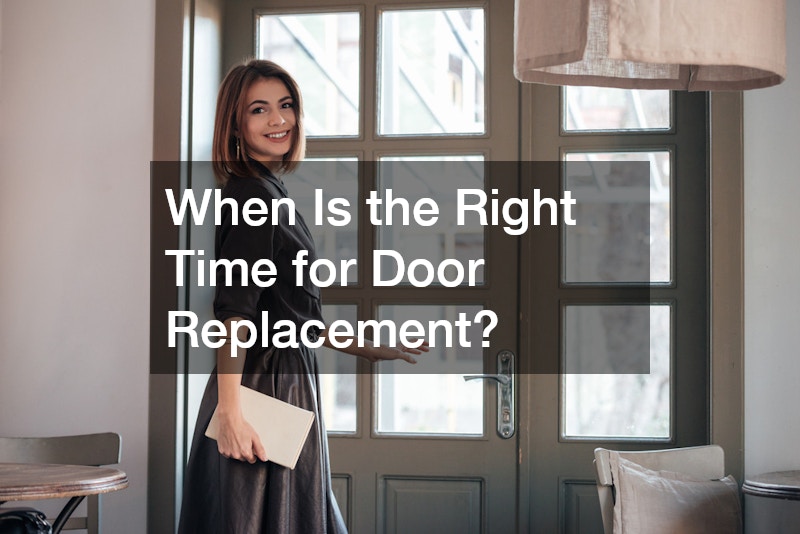Doors are integral components of our homes, playing crucial roles in security, insulation, and aesthetics. Yet, many homeowners overlook the need for timely door replacement, often dismissing subtle signals of wear and inefficiency. Recognizing the right time to replace your doors can lead to increased property value, reduced energy bills, and improved home comfort.
Replacement is not just about aesthetics; it addresses structural problems that can affect both the safety and energy efficiency of your home. Over time, doors may suffer from damage due to weather exposure, wear out due to usage, or become outdated in style. Understanding when to replace a door is essential for maintaining a well-functioning and visually appealing home.
In this article, we will explore the signs that indicate it’s time for replacement, the benefits it offers, and how often a homeowner should consider replacing their doors. Investing in new doors not only enhances your home’s exterior appearance, but also provides practical benefits that are often overlooked. Let’s delve into the key aspects that determine the right time for replacement.
Signs It’s Time to Replace Your Door
One common indicator of the need for door replacement is visible damage. Cracks, warping, and other deformities compromise the door’s structural integrity and security features. If your door shows significant wear and tear, it is a clear sign that it’s time to consider replacement.
Another critical sign is drafts or air leaks around your doors. This situation leads to higher energy bills as your heating and cooling systems work harder to maintain indoor temperatures. Investing in energy-efficient doors can significantly reduce energy consumption and, in turn, lower utility costs.
If your door struggles with operation—whether it’s sticking, squeaking, or failing to latch—it’s a sign of a failing door. These operational issues are not just nuisances; they may also point to underlying structural problems. A new door can offer smoother operation and enhanced security, something important for peace of mind.
Choosing the Right Material
Choosing the right material for door replacement is crucial, as it affects the door’s durability and performance. Wood doors offer classic beauty and strength but may require regular maintenance to prevent warping. For a timeless look combined with stability, many homeowners opt for energy-efficient fiberglass doors.
Steel doors, on the other hand, are notable for their strength and security. They are less prone to warping and offer good insulation, making them ideal for exterior replacement. However, they can be susceptible to dents and may require repairs over time to maintain their appearance.
Vinyl doors have become popular due to their affordability and minimal maintenance requirements. They offer excellent insulation properties, contributing to energy efficiency. When considering replacement, assess which material aligns best with your budget, maintenance capacity, and home protection needs.
The Benefits
Replacing old doors provides multiple benefits, including improved home security. Modern doors are designed with advanced locking systems, offering increased protection against intrusions. When considering door replacement, security enhancements should be a top priority.
Another significant benefit is the improvement in energy efficiency, which lowers heating and cooling costs while reducing your environmental footprint. New doors often come with enhanced insulation capabilities, curbing drafts and minimizing heat loss. This creates a more comfortable living environment year-round.
Replacement also leads to aesthetic enhancement, increasing your home’s curb appeal. New doors can be a focal point of your home’s exterior design, offering a fresh and modern appearance. This improvement can lead to increased property value, making it a wise investment long-term.
How Often Should You Replace Your Door?
The frequency of door replacement depends on various factors, including material, climate, and usage. On average, doors may need replacement every 15-30 years to maintain optimal functionality. Keeping an eye on wear and tear will help you decide when replacement is necessary.
Regular maintenance can extend a door’s lifespan, but eventually, replacement becomes unavoidable due to wear and evolving style needs. Homeowners living in harsh climate zones might experience more frequent replacements. Constant monitoring and proactive replacement are key to preventing deteriorating door conditions.
Replace doors before significant structural or style issues arise to avoid compromising home security and energy efficiency. Thoughtful planning ensures you replace doors at the right intervals, balancing cost with necessity. Aligning with home renovation projects is an efficient strategy for planning replacement.
Recognizing when it’s time for replacement can significantly impact your home’s safety, efficiency, and aesthetics. By identifying the signs and understanding materials, you can make informed decisions about which doors best suit your home. This ensures your living space remains secure, visually appealing, and energy-efficient.
Whether updating outdated doors or addressing operational issues, investing in new doors yields multiple benefits. Improved security, reduced utility bills, and heightened aesthetic appeal are just a few outcomes of replacing worn-out doors. Consider replacement a worthy investment in your home’s future.
Ultimately, selecting the right time for door replacement hinges on understanding the specific needs and conditions of your home. By doing so, you maintain both its function and curb appeal, ensuring your property remains a cherished and valuable asset. Proactivity and diligence in replacing doors transform them from potential liabilities into key advantages for your home.



